When my wife’s vehicle had a very low battery a couple of weeks ago, I naturally grabbed my trusty battery charger and the car was back in business in a couple hours. It got me wondering though, how long it would take to charge a car battery at idle if I were to just leave it running in the driveway.
I know it’s not the smartest or the most efficient way to charge a car battery, but I was still curious to find out.
I scoured the internet and came across tons of forums and websites that didn’t directly answer the question and all of them seem to give ballpark estimates which varied wildly from one person to another. No one seemed to have done even a basic test.
Since I have a multimeter and a clamp-on ammeter, I decided to set up a quick experiment and see what I could find out. If you’re just here for a quick and easy answer I’ll give you that below, and if you’d like to read up on my experiment and what I found out then keep on scrolling!
At idle, a car battery can be functionally recharged in 75 minutes when at 50% capacity, or about 2.5 hours when fully discharged.
Do Car Batteries Charge While Idling?
First, let’s address the common question above with regards to your vehicle running at idle.
Car batteries will charge at idle as long as your alternator is functioning properly and there are no weak connection points. To maximize charging at idle, turn off all accessories, air conditioning, and lights if possible to reduce stress on the alternator.
If you turn on every accessory, every light (both interior and exterior), max out the air conditioner, turn on your heated seats, the wipers, defrost, and every other thing that you can think of then it is possible to max out your alternators ability to produce enough electricity while at idle without increasing the RPMs.
You would be pretty hard-pressed to do this with stock items in your car, but if you install aftermarket accessories then it is certainly possible.
Modern vehicles are saturated with on-board diagnostic and computer systems. Naturally, they have systems that protect your car’s battery from being overcharged, and from my experiment, the charging system of a car seems to run very similarly to a smart charger.
By this I mean that when the voltage is low on the car battery, the alternator will provide more amps to the battery because the battery can easily accept them.
As the battery charges more and more, the amperage actually decreases just like a smart charger would do so that the battery does not overcharge.
In other words, there exists an onboard system that monitors the battery’s health and provides the battery the correct amperage to prevent the battery from being damaged. There is not a constant steady-state of amperage being pushed into the battery regardless of whether or not it can accept it.
Now, for the experiment!
How Long Should I Idle my Car to Charge My Battery?
The Battery Charging Experiment at Idle:
This was a pretty fun experiment test out!
My car battery is rated at 590 Cold Cranking Amps, which I estimate to be about 60-65 amp-hours based on the work I did in an article here which estimates amp-hours based on cold-cranking amps.
I first took a reading of my car battery that has been sitting in the driveway for the last 24 hours without being driven. My voltage was at 12.55. Pretty much 95% of a healthy battery’s capacity. Keep in mind though, that my battery is 4+ years old, so I don’t think it is staying at the ideal 12.65-volts.
I hooked up a clamp-on ammeter (Amazon link if you’re interested in buying one — just make sure to get the one for DC current if you want to test your battery) to the positive cable of the car battery (which simply allowed me to hook it up and read it easier) and turned on the low-beam headlights to establish which direction the current was flowing through the ammeter.
I hooked up the ammeter for ease of reading. As you can see below, the number is positive indicating that the direct current is flowing in a particular direction — in this case out of the battery despite the lack of a negative symbol.

I then started the vehicle and turned off every accessory possible and hooked up the clamp-on ammeter to the positive cable of the car battery again in the same orientation and looked at the screen.
The amps started high by the time I got to look at the screen and were around 20 amps but within 60 seconds they were down to about 10. Within the next 4 minutes, the amps were around 1.5. After five more minutes, they were still around 1.5.
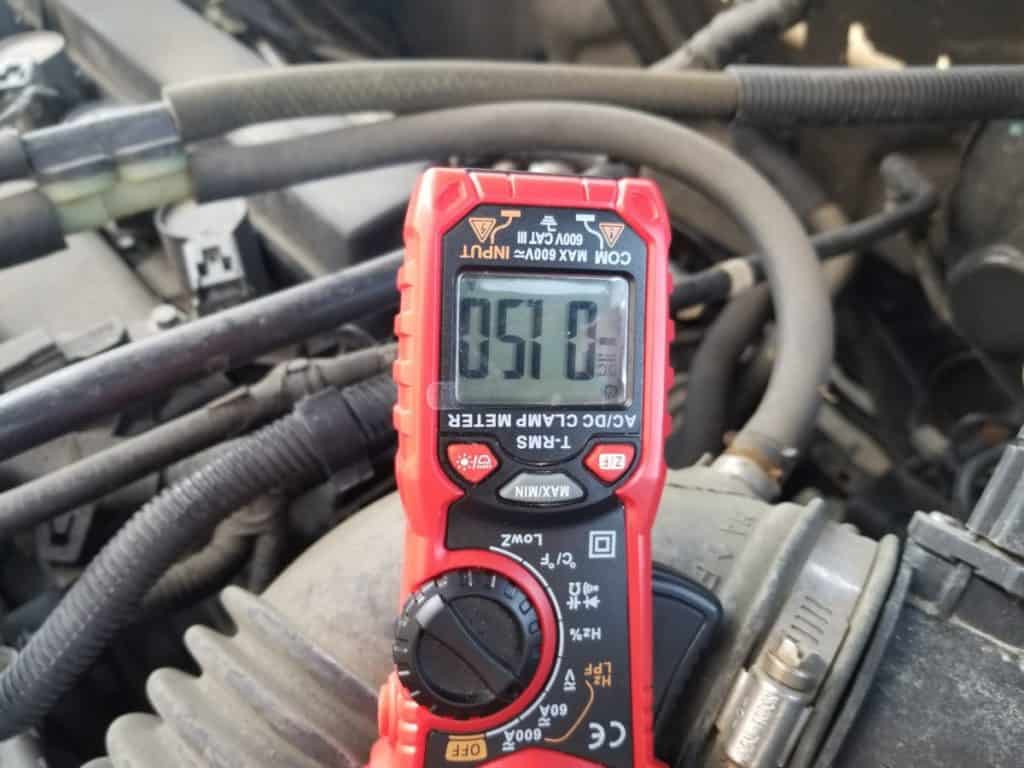
1.5-amps for 5 minutes established my baseline for “functionally charged” in this experiment.
Since my battery was pretty much at 95% to begin with, I figured that the reduced 1.5 amps would be a good indicator for when the battery is at least 95% charged and entering into float mode. An actual battery charger might not say it’s 100% charged by its standards, but I was not going to waste the gas to see if the amps would go any lower just to gain an extra 0.1 of voltage.
Float modes with regular battery chargers can last for an hour or more to bring the battery up from 95% to 101%. This experiment was to be functional, practical, and attain a ballpark estimate — not drain my entire gas tank.
Next, I turned on the headlights while the car engine was off and set a timer for 20 minutes to drain the battery a bit. When that was done I returned to the vehicle and let the high beams run for another 5 minutes.
I then turned off the lights and waited for 30 minutes to let the battery surface charge settle out.
Immediately after turning off the lights, the battery was at 12.09-volts, and after 30 minutes it was at 12.19-volts and did not deviate from that with another check a few minutes later.
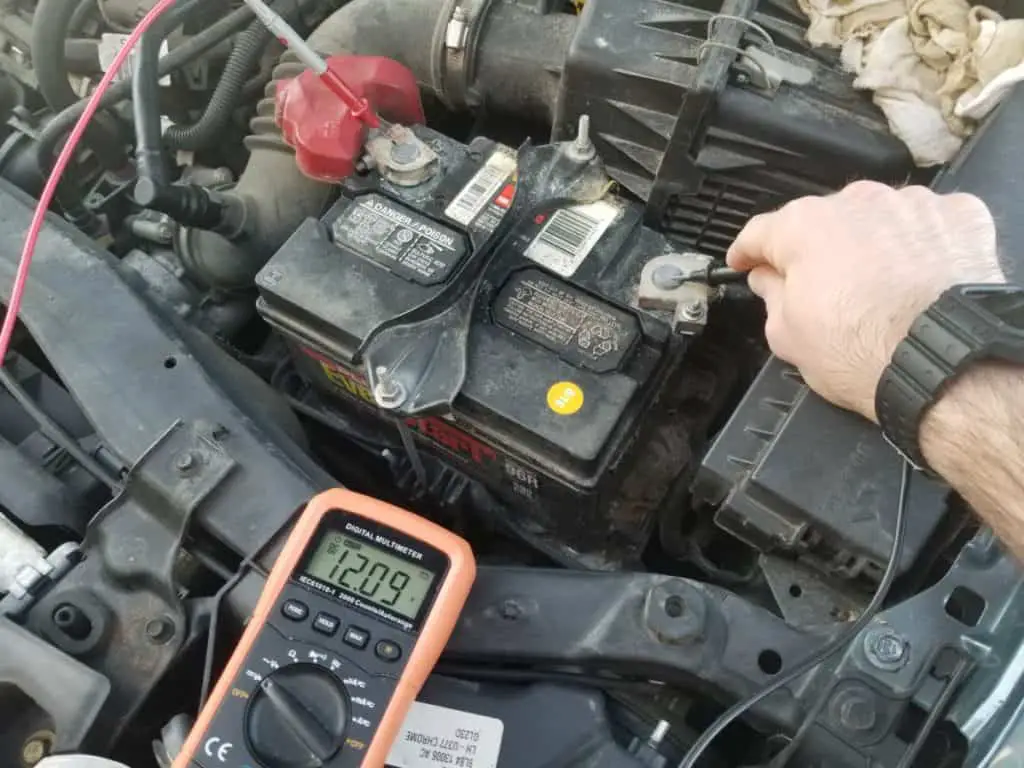
Percent of Battery Charge Remaining by Voltage
| 100% | 12.65+ |
| 90% | 12.5 |
| 80% | 12.42 |
| 70% | 12.32 |
| 60% | 12.20 |
| 50% | 12.1 |
| 40% | 11.9 |
| 30% | 11.75 |
| 20% | 11.6 |
| 10% | 11.3 |
| 0% | 10.5 |
12.19 indicates that after 25 minutes of running the headlights (a mix of high and low beams) on my four-year-old battery, I had lost 40% of my charge (of the battery’s total capacity, that is, assuming fully charged is 12.65).
I then started the vehicle and started the ammeter once again on the positive cable of the car battery in the same orientation. Amps read between 17 and 20 for the first 3 minutes, then slowly dropped about 1 amp every minute until they got 12 amps.
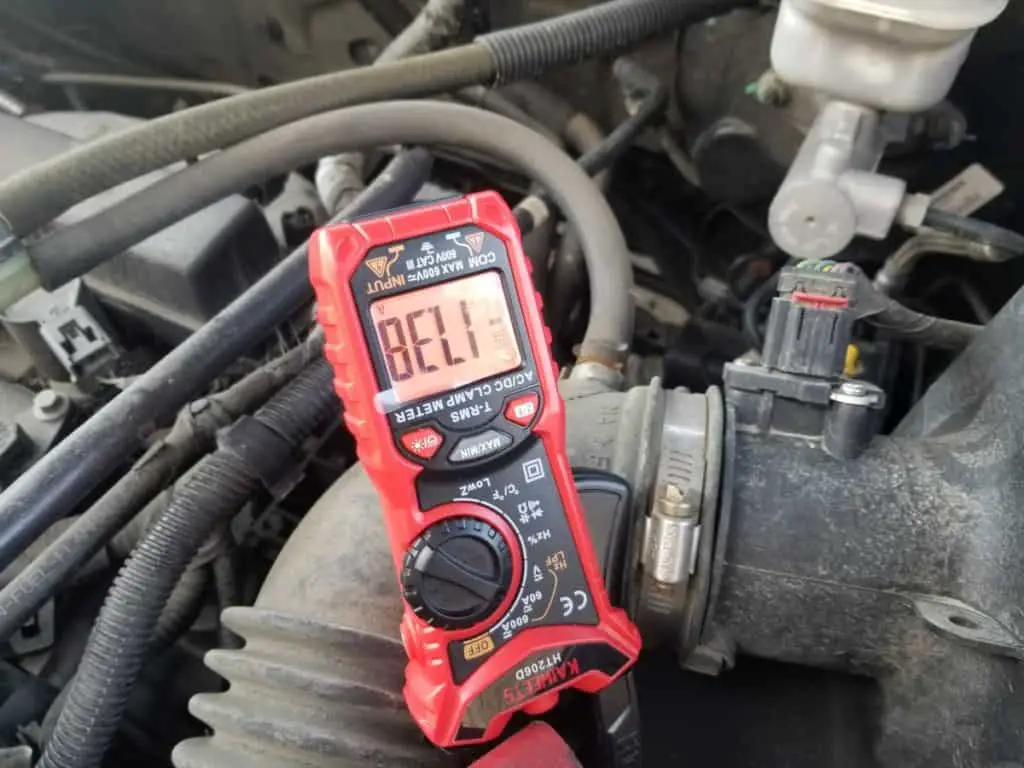
Voltage remained between 14.71 and 14.73 during the entire test, and the temperature was 30 degrees Fahrenheit.
From minutes 8 until about 20, the amps slowly fell from 12 to 10 amps.
From minutes 20 until 30, the amps slowly dropped from 10 to 8.
From minutes 30 to 40, the amperage dropped slowly from 8 to 5.
From minutes 40 until 50, the amps flowing through the ammeter went from 4, then 3, then 2, and finally 1.5 at the 52-minute mark.
I allowed the car to run for another 5 minutes at 1.5 and considered 57 minutes at idle to be “functionally charged” for my purposes and hypothesized that the voltage of the battery was where it used to be before the test.
After turning off the car, I turned the headlights on for about 30 seconds to help reduce the surface charge of the now-charged battery and allowed the car to sit for a full hour afterward.
When I returned, I tested the open voltage on the terminals and got a reading of 12.66. Perfect for my standards! After rechecking 20 minutes later, I got 12.65 volts.
***After 8 hours, the voltage settled back to 12.55 (0.01-volts more than before the test), which might be where my battery wants to be considering its age (2016, now 2021).
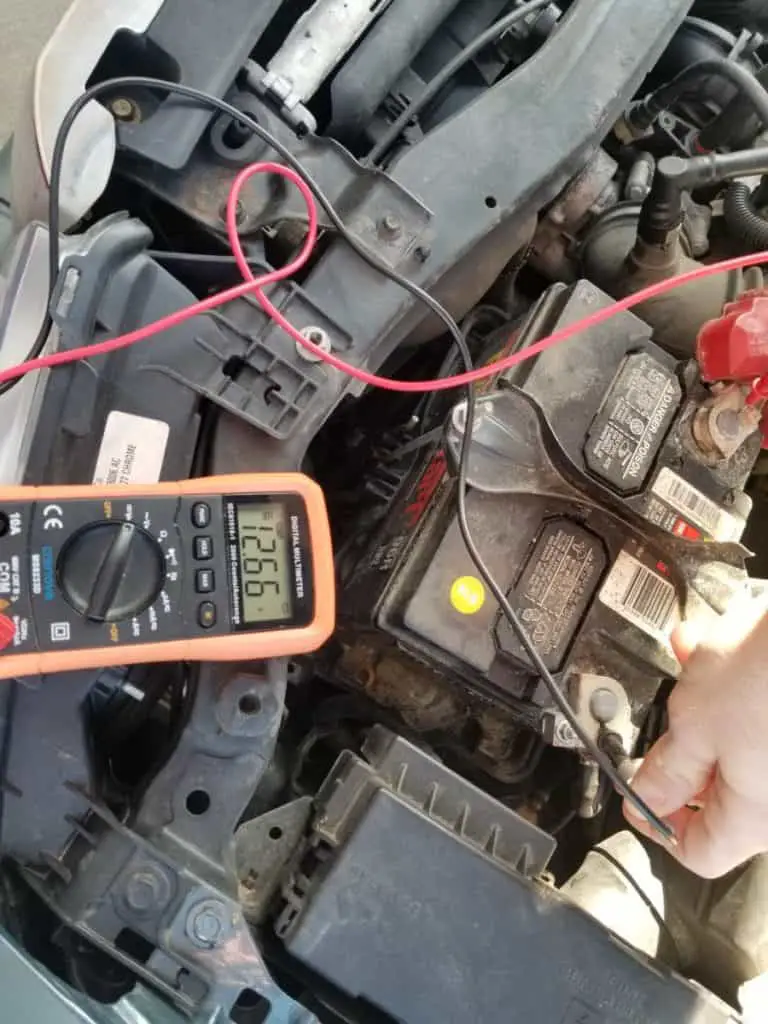

Results and Key Takeaways of the Idle Time Charge Test:
- I was able to replenish 40% of my battery’s ideal capacity in 57 minutes which averaged out to 10% every 14.25 minutes or so. I am not claiming the relationship between charge time and the total charge is linear! It most certainly isn’t. This is just the average for the purposes of making a ballpark estimate.
- The car’s charging system behaved like a smart charger by providing the battery with lots of amps during the absorption phase (when the battery is below 85% state of charge) and gradually reduced the amperage as the battery approached being fully charged. However, unlike a smart charger, the charging voltage did not change during the charging process.
- The voltage stayed constant at 14.73 (+/- 0.1) which I expected because it was cold and the internal resistance of the battery would have to be overcome. Despite things definitely warming up under the hood, there was no change in charging voltage.
- My battery has a sticker date of August 2016 and it is March of 2021 at the time of this article but has yet to give me any problems, even during our -5 degree Fahrenheit days this winter. Still, I think it’s worth mentioning. I have kept it well maintained with a monthly charge from a dedicated charger for the last several years.
Applying Results and Disclaimers:
It might be a little bold to make a table such as this after running a single experiment, from a single vehicle, from a single starting voltage, but I’ll do so anyway for a simple “ballpark estimate” when it comes to charging times.
***I do not recommend charging a vehicle’s battery at idle outside of normal driving operations. It is inefficient, a waste of gas, and causes unnecessary wear and tear on your engine and alternator. ***
Car Charging Times at Idle
| Battery Voltage and Percent | Charging Time at Idle (Minutes Rounded Up) |
|---|---|
| 12.5v (90%) | 15 |
| 12.42 (80%) | 29 |
| 12.32 (70%) | 43 |
| 12.2 (60%) | 57 |
| 12.1 (50%) | 72 |
| 11.9 (40%) | 86 |
| 11.75 (30%) | 100 |
| 11.6 (20%) | 114 |
| 11.3 (10%) | 129 |
| 10.5 (0%) | 143 |
How Long Can a Car Battery Sit Unused?
Older vehicles with few electronics on board can go 3 to 4 weeks until the battery will be too weak to start the engine. Modern vehicles are laden with electronics that are all on standby mode when the vehicle is turned off and will not start after 7 to 14 days of being parked.
If you know that you’re going on vacation, it is best to bring your vehicle in the garage and simply hook up a smart charger, like this one seen on Amazon. It will provide a gentle charge to your vehicle’s battery and you can leave it hooked up indefinitely without any damage. It will ensure that your battery is in tip-top shape when you’ve returned and your vehicle will start without any issues. I’ve used one of these for over 6 years.
If you cannot leave your vehicle hooked up to a charger while you’re away for an extended period of time, you can simply disconnect the cable that leads to the negative terminal of your battery. This will stop any flow of electricity from your battery to the vehicle to maintain any electronics that are on standby mode and you won’t be affected anymore by parasitic draw.
You will, however, lose your radio presets but that’s a small price to pay for being able to start your vehicle up when you arrive back to the airport when you’ve been gone for a month.
Just be sure that you do have a way to open your doors if your battery is disconnected. Make sure that you have a keyhole somewhere on one of your doors to insert the key in manually open the lock, and remember to keep your tool to hook up your battery again somewhere handy.
You may have noticed that I mentioned taking off the cable from the negative terminal of the battery and wondered why not the positive one or both. Just breaking one of the connections will stop the flow of electricity so you do not have to do both. Disconnecting the negative terminal is the safest one to disconnect.
All of the vehicle’s electronics have a positive cord coming from the vehicle’s battery but their negative cord to complete the circuit is simply attached to the frame of the vehicle. The cables that run to the negative terminal of your battery are simply attached to the frame as well.
This means that if you are disconnecting the positive cable with a wrench and accidentally touch the handle of the wrench to any part of the frame of the vehicle (or anything metal that is connected to the frame), then you will instantly create a direct short with the battery.
Current will flow immediately from the positive terminal of the battery that you were disconnecting, through the metal tool, and directly to the frame where it loops back through the cable that goes to the negative terminal of the battery.
The tool will immediately become too hot to touch and will burn you. If you don’t sever the connection, it can melt into the battery case and create an explosion.
Just stick with removing the negative terminal.
How to Charge a Car Battery While Parked
Despite the work I did testing the charging rate of a battery when the car is at idle, I do not recommend it. As I said before, it is inefficient, a waste of gas, and causes wear and tear on your vehicle.
If you’d like to know how long it would take to charge your particular battery with your particular charger, I have an easy-to-use calculator where you can plug in a couple values and get a good estimate here.
The alternator is intended to top off your battery, not be a dedicated charger.
Do yourself a favor and pick up either of these smart chargers from Amazon. This one is a 4-amp model and this one is 5-amps. Both are the perfect amp rating for getting your car battery fully charged overnight, even if the battery was really drained. The 5-amp model is advertised for marine batteries because it can be permanently mounted, but it is perfectly fine for your vehicle.
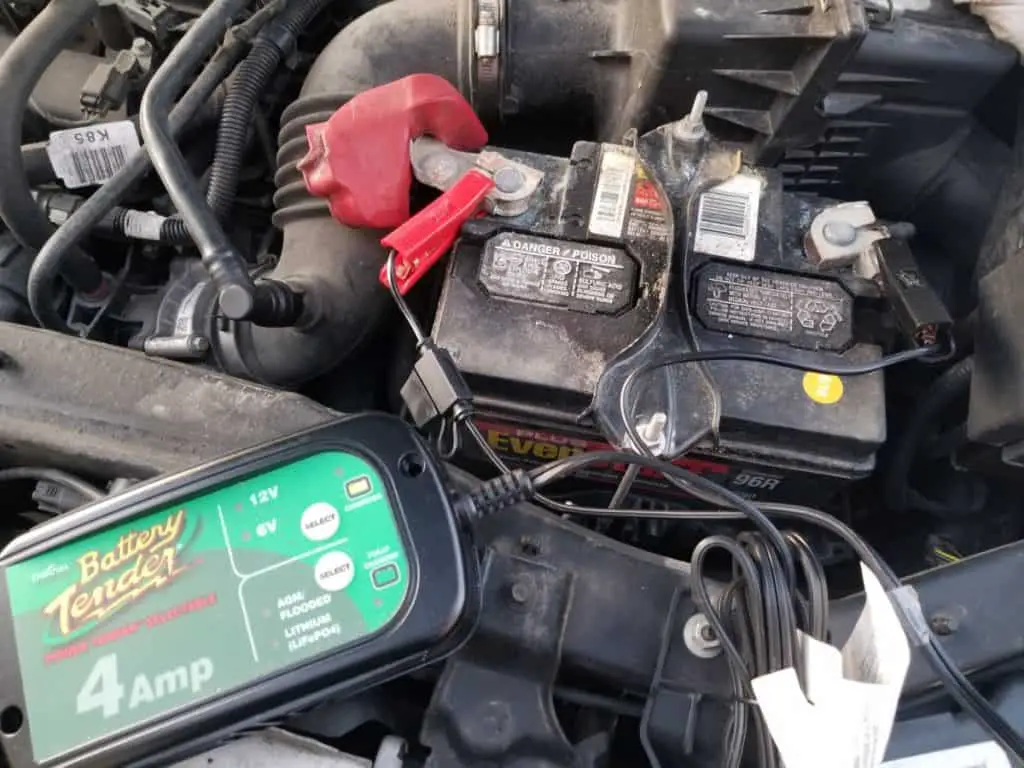
They will not overcharge your battery, are gentle, and will enter into a float mode when the charging reaches 100% so that you can actually leave them connected indefinitely.
Since they are a smart charger that is microprocessor controlled, you do not need to disconnect your car battery before hooking it up.
I’ve used them for over 6 years and can’t recommend them highly enough.
Thanks for the read, and have a great day!
